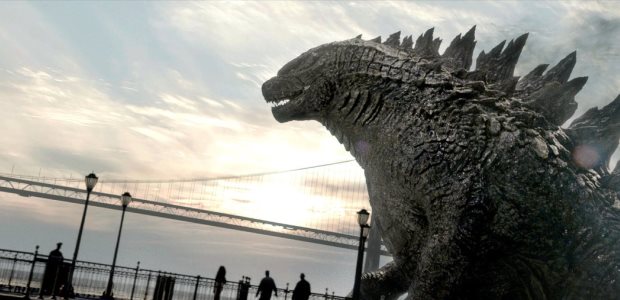It took them a good 16 years, but Hollywood has finally got it right: Gareth Edwards’ Godzilla is a massive achievement in realizing the King of Monsters for the big screen. The director takes his time in finally showing us the mean giant in his movie, but when Godzilla does finally and fully appear, do remember to pick your jaw from the floor. The movie gives the big beast the essential treatment he deserves that was severely lacking from his previous big screen outing: awe, respect and spectacle. This ensures that the new generation has a reason to enlist in the fandom of the greatest movie monster ever.
The movie starts in 1999, at the Janjira nuclear plant in Japan where Joe Brody (Bryan Cranston) is the chief engineer. A “natural” disaster causes a plant meltdown and destruction in which Joe loses his wife. In the present day, Joe is still looking for answers when the cause of the “natural” disaster resurfaces: a massive parasitical beast that feeds off radiation. While Joe, his now-grown son Ford (Aaron Taylor-Johnson), scientist Dr. Ishiro Serizawa (Ken Watanabe) and US Navy Admiral William Stenz (David Strathairn) try to make sense of and deal with the mayhem, another gigantic beast appears. This one is reptilian, larger and looking for a fight. They codename him Godzilla.
The biggest achievement of Gareth Edwards in bringing his indie film sensibilities to this big budget production is to not reduce the movie, and the titular monster, to a mind-numbing special effect mock-up. Like Ang Lee’s Hulk and Christopher Nolan’s Batman Begins, this is an origin story that builds towards an iconic first-appearance. It takes half the runtime of the movie before glimpses of Godzilla’s anatomy are shown and a little longer before his full appearance on screen. Even in a movie with a run time of 123 mins, this first act feels deliberately paced and languid. It doesn’t help that the main human character is played by Aaron Taylor-Johnson, severely lacking in leading man abilities. But Edwards’ emphasis on the human story and perspective (the monsters are almost always seen from human point-of-views instead of a floating ubiquitous cameras) is what sets the movie apart from being another forgettable Michael Bay-ish summer product.
Where the movie shines flawlessly is in its spectacular middle-to-final acts. Once Godzilla eventually appears, teasing all done, he completely takes over and erases any issues the movie had. Holding him back and unleashing him finally generates a payback that ensures audience don’t just get their money’s worth, they will most likely be returning back for more. The movie also boasts of dazzling visuals from Seamus McGarvey, the man who earlier lensed The Avengers, from atmospheric shots that hint at impending danger to the money shots of the beasts and their destruction. Unfortunately, the movie could have done with a better score from Alexandre Desplat’s, who doesn’t produce an iconic enough theme.
Perhaps taking a lesson from the 1998 movie’s misstep, Gareth Edwards understands that the portrayal of Godzilla on the big screen isn’t about just making him a brutal and destructive force of evil. Godzilla has been at his best, like in this film, as an anti-hero: one that is destructive to humans (without intention), but is also our only saviour against other malevolent beasts. Consequently, this movie becomes a celebration of the screen legend in a non-exploitative manner. I suspect this is exactly what the goal of the movie was. Finally, this generation has its own iconic Godzilla.
Rating: 




